The recent drone strike hit a residential building in Tel Aviv’s Neve Tzedek neighborhood, just 1.2 kilometers from the U.S. Embassy. This high-security area sits near HaKirya military headquarters, making it both a strategic and controversial target. Israeli defense systems, including Mini-Typhoon turrets, were activated but failed to intercept the military-grade drone. Emergency responders quickly established triage protocols in the densely populated coastal area. The attack’s precision raises serious questions about evolving aerial threats!
Key Takeaways
- Strike targeted a residential building in Tel Aviv’s heart, near the U.S. Embassy in a high-security zone.
- Located in a densely populated coastal neighborhood with sophisticated surveillance systems.
- Proximity to HaKirya military base, civilian neighborhoods, and diplomatic missions increases strategic significance.
- Urban terrain’s vertical profile aided the drone’s approach, evading initial detection systems.
- Area houses both military installations and civilian infrastructure, including healthcare facilities and commercial centers like Carmel Market.
Precise Geographical Impact Points of the Attack
The heart of Tel Aviv shuddered yesterday as a drone strike pierced the city’s normally secure airspace. The attack targeted a residential apartment building near the U.S. Embassy, situated in one of Tel Aviv’s densely populated neighborhoods along the Mediterranean coast.
A Geographical History of the area reveals it has long been considered a high-security zone, with sophisticated surveillance systems that, surprisingly, failed to detect the incoming threat! The Terrain Analysis suggests the urban landscape may have actually aided the drone’s approach, allowing it to blend with the city’s vertical profile until the final moments. The strike’s location, nestled between diplomatic missions and civilian housing, highlights the tactical complexity of protecting coastal urban centers against these increasingly common aerial threats. Notably, military-grade drones like the RQ-11 Raven UAV are designed for precise reconnaissance, illustrating the advanced capabilities that can challenge even well-guarded zones.
Proximity to Key Civilian and Diplomatic Infrastructure
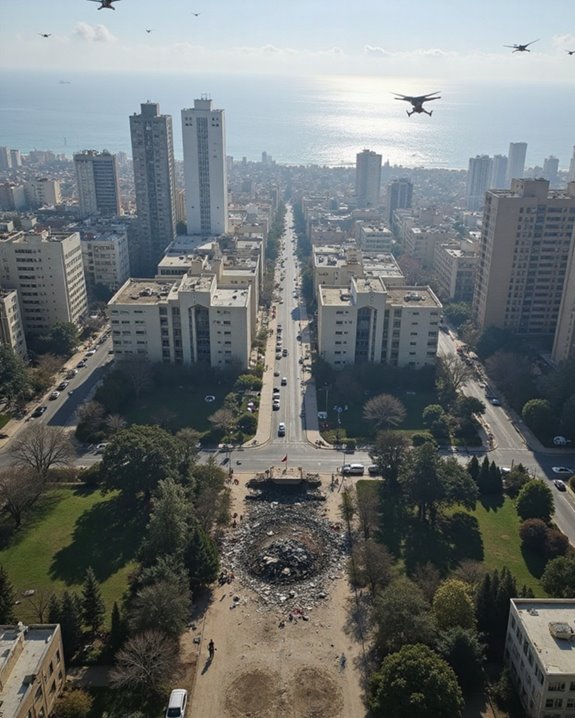
Where exactly did yesterday’s drone strike fall within Tel Aviv’s complex web of sensitive locations? The impact occurred dangerously close to both HaKirya military base and surrounding civilian neighborhoods, creating significant Diplomatic Risks for Israeli officials. The strike’s proximity to ICRC offices and several foreign diplomatic missions raises serious questions about targeting protocols!
Tel Aviv’s unique layout, with military installations nestled within densely populated areas, has long challenged Civilian Planning efforts. Just blocks from the impact site, you’ll find bustling commercial centers, the beloved Carmel Market, and critical healthcare facilities serving thousands daily. This integration of military and civilian spaces—something urban planners have debated for years—creates an unfortunate perfect storm of vulnerability during attacks like yesterday’s drone incident.
Pre-Strike Aerial Tracking and Defense Responses
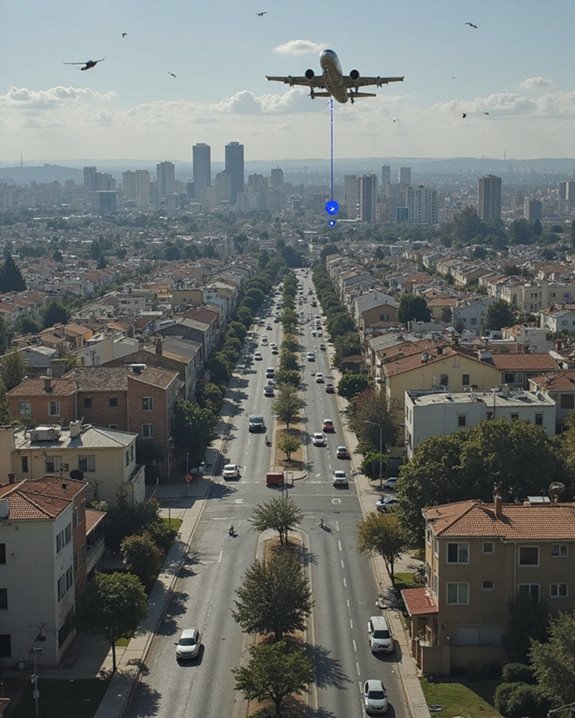
While Tel Aviv residents were still processing the shock of a strike so close to civilian areas, behind the scenes a sophisticated ballet of defensive technologies had been actively tracking the incoming threat. Israel’s integrated Aerial Surveillance systems, which combine multiple sensor arrays optimized for small drone detection, had been monitoring the airspace continuously.
Defense response teams activated established Response Protocols, deploying a layered approach that included both the recently-tested 30mm cannon systems and interceptor UAVs. The Mini-Typhoon remotely-controlled turrets, a crowd favorite at recent defense exhibitions, sprang into action! Despite these measures, the distributed command structure—a hallmark of Israel’s revamped defense strategy—faced challenges with the drone’s speed and altitude profile. Nine defense companies, including hometown heroes Elbit and Rafael, are now racing to close these defensive gaps. Additionally, advanced signal blocking technologies are being explored to enhance protection against drone communications and improve interception success.
Casualty Assessment and Emergency Medical Operations
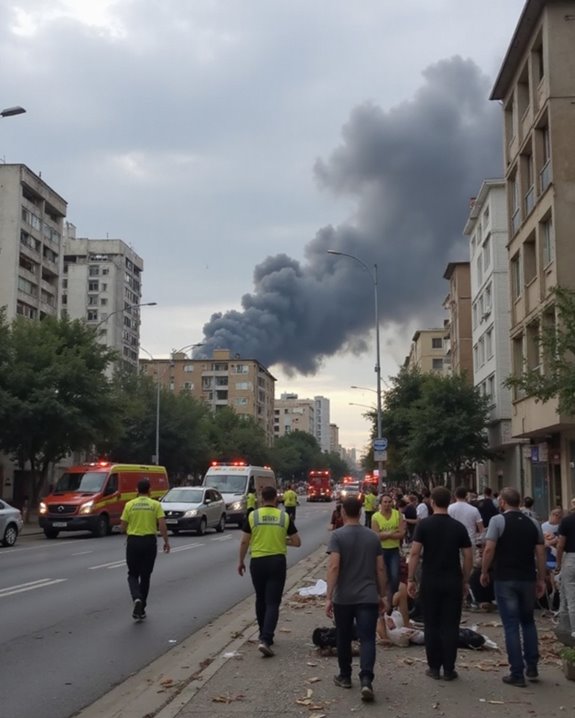
Racing against time, medical crews converged on the drone strike site in Tel Aviv while smoke still billowed from the impact zone. Emergency responders immediately implemented casualty triage protocols, sorting victims by injury severity to maximize survival rates.
“Our first priority is stabilizing the critically wounded,” explained Dr. Levin, head of emergency services. “We’ve activated our blood management system to secure adequate supplies for surgeries.”
Mobile trauma units established a perimeter around the impact site, while dedicated evacuation routes helped transport victims to nearby hospitals. The central command post coordinated ambulance traffic, preventing bottlenecks that could delay treatment.
Meanwhile, psychological support teams arrived to assist both victims and first responders dealing with trauma. The efficiency of this response system, tested through numerous drills, proved invaluable in the chaotic aftermath!
Strategic Significance of Tel Aviv as a Target
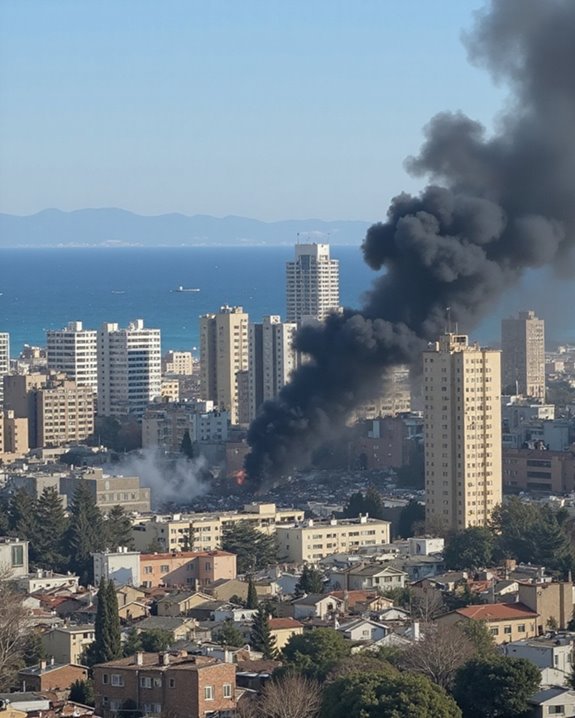
As the medical teams worked tirelessly to save lives, the smoke-filled aftermath laid bare a somber reality about why Tel Aviv became the target of this attack.
The city represents a strategic Geopolitical Hub where Israel’s economic, technological, and military interests converge. With Israel accounting for 2.3% of global Military Exports between 2018-2022, Tel Aviv’s significance extends far beyond its Mediterranean coastline. The dense metropolitan area houses critical military research centers that drive innovation in defense technologies—making it an attractive target for those seeking to disrupt Israel’s capabilities. Its proximity to conflict zones and role in regional security operations further amplifies its strategic value. Talk about a bullseye on the map! The city’s dual identity as both a vibrant tech center and military powerhouse creates a unique vulnerability that adversaries clearly recognize. This vulnerability underscores the importance of deploying FAA-approved drone detection systems to enhance security and counter emerging aerial threats.
Technological Analysis of Houthi Drone Capabilities
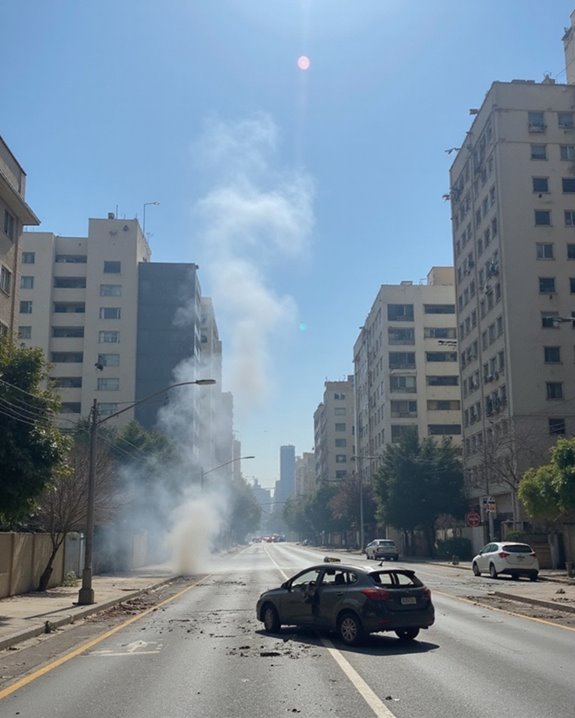
The recent Tel Aviv drone strike reveals a sobering evolution in Houthi aerial warfare capabilities. Their UAVs now incorporate advanced Propulsion Systems, including the 3W-110i B2 engine found in Sammad-pattern drones and, more alarmingly, jet engine technology that dramatically increases both range and speed!
Design Innovations are equally impressive, featuring tube-like fuselages that optimize aerodynamics while maintaining a low radar cross-section. You might be surprised to learn these drones utilize satellite navigation-assisted inertial guidance systems, making them remarkably precise even in GPS-denied environments. The vertical gyroscopes installed in these aerial platforms provide stability that would make commercial drones jealous, allowing them to navigate complex environments with ease. These technological advancements, combined with swarm tactics, create a formidable threat that conventional air defenses struggle to counter.
Frequently Asked Questions
What Security Measures Changed for Tel Aviv Residents After the Attack?
While Tel Aviv once prided itself on carefree living, residents now face increased security checks, surveillance, and regular emergency drills. New Resident Alerts systems and enhanced Defense Protocols were implemented following the attacks.
How Did International Airlines Respond to the Airport Missile Strike?
International airlines immediately suspended flights to Tel Aviv following the missile strike, with major carriers implementing airline bans for multiple days. Flight diversions and cancellations affected operations across Europe, Asia, and North America.
What Role Did U.S. Intelligence Play Before the Drone Attack?
U.S. intelligence agencies provided early warnings through Intelligence Cooperation with Israeli counterparts, utilizing advanced Surveillance Techniques to monitor Iranian proxies’ activities and drone movements before the attack occurred, sharing critical threat assessments.
Who Manufactured the Drone Technology Used by Houthi Forces?
Houthi drone technology primarily originates from Iranian technology transfers. Drone sources include the domestically manufactured Sammad series and Rujum models, though the tech origins trace back to Iranian designs and manufacturing expertise.
Did Israel Anticipate Retaliatory Attacks Following Military Operations in Gaza?
Israel anticipated some retaliatory attacks following Gaza operations, implementing Warning Systems throughout border regions. However, intelligence assessments reflected Foresight Errors regarding the timing, scope, and nature of enemy responses.





